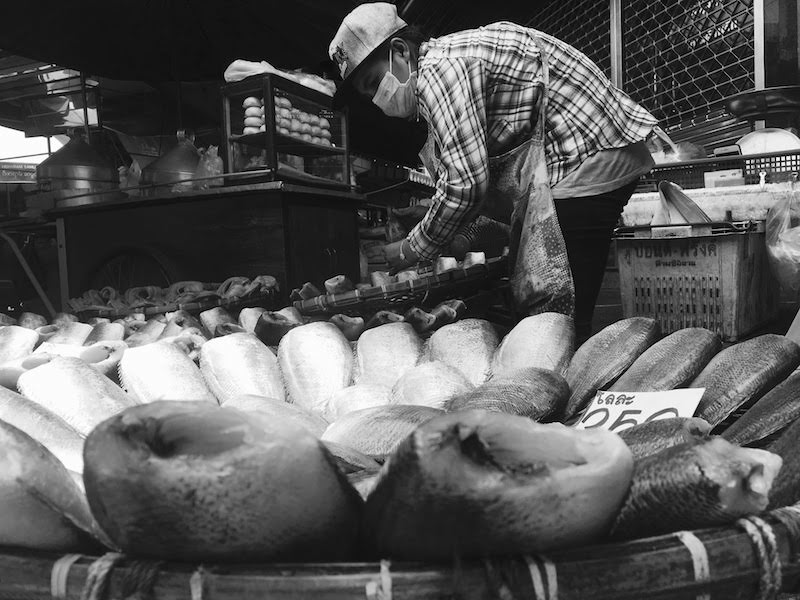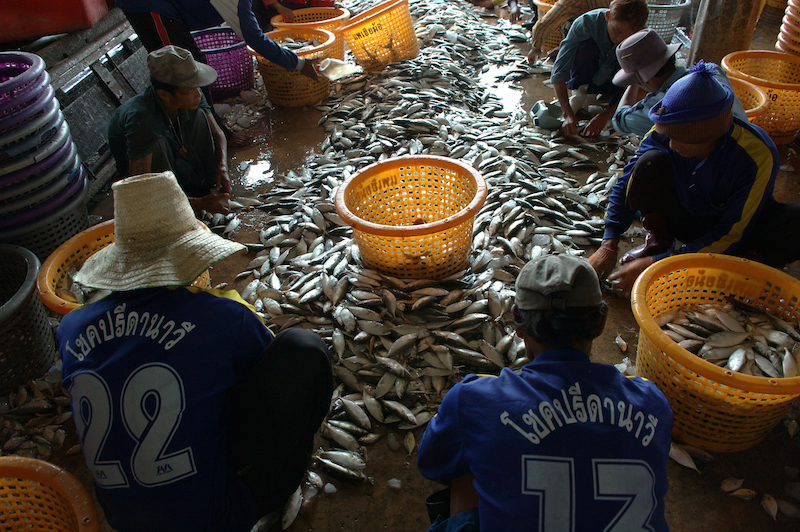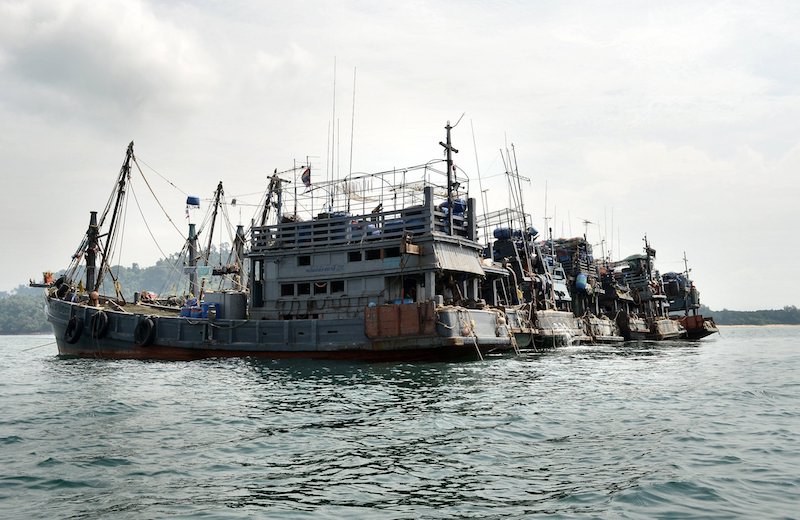Slavery Still Persists in Thai Fisheries
[By JJ Rose]
About an hour south of Thailand’s capital, Bangkok, down a dusty, broken-edged road, dotted with grimy stores and street stalls, with the incessant buzz of motorbikes, stands a desolate building complex. Turn right at the festering drain, past the guard dozing in his chair, and the dog licking itself on the pavement, if you look hard, you’ll see an office.
A swarm of children race by. The disruption hardly ruffles a group of perhaps 10 young people sitting at a long table in this place known as Samut Sakhun, each with a laptop flipped up and phones in hands. It’s early afternoon and the atmosphere is sleepy, the daylight is ebbing. A blue sign, “Fishermen Centre”, squeaks as it swings.
In this dreary space, thousands are saved.
Here they rescue slaves.

Fishing boat off the coast of Samut Sakhun (Photo: Byron Lippcott/ Flickr)
Samut Sakhun sits in the armpit of the Gulf of Thailand. The Gulf is a vast fishing haven of some 320,000 square kilometres, washing onto the shores of Cambodia, Thailand, and Vietnam, merging with the South China Sea to the east.
Due to its relatively shallow depth, its slow flow, and robust good health, the area is rich with food sources for sea life. It is, as a result, heavily fished and regularly tussled over. Almost half of Thailand’s entire seafood catch is from the Gulf of Thailand.
Important seas for Thailand. But there are global dimensions too. Thailand is the world’s largest exporter of tuna and is the third biggest seafood exporter.
The spectre of slave fishermen being used to haul in the catch looms are an unavoidable problem for major buyers in the United States – the world’s major consumer of imported seafood – and the European Union.
These men are held on boats at sea, sometimes for years, often beaten while working punishing long shifts for no pay.
Being such an informal and dispersed economy, its hard to nail down exact figures. Pulling together recent numbers from the Thai Department of Fisheries and estimates from local NGOs, it is likely that there are at least 17,000 fishers plying the waters of Southeast Asia who are considered slaves.
“Slaves” is the right word for these men held on boats at sea, sometimes for years, often beaten while working punishing long shifts for no pay.
A campaign to highlight this labour abuse in the Thai fishing industry has, to say the least, focused the minds of lawmakers in Bangkok. The Royal Thai Government has introduced a range of measures designed to, if not end the slave trade overnight, then at least take the spotlight off it.
The government has told all trawler owners to ensure there is adequate communications technology on every ship, and to allow all workers to freely contact families while on board. They have banned fishermen working under the age of 18 and have sought to mandate a system of electronic bank transfers for wages to enable verification that the fishermen are in fact being paid.
Most recently, it has published details of the 10,742 fishing vessels it says are registered to fish in its waters.
Despite these efforts, many men are still enslaved.
I made contact with Steve Trent from the London-based Environmental Justice Foundation after he made comments full of candour and marked by palpable frustration to The Guardian earlier this year about how the fishing industry is facing up the massive problem in its midst.
Trent took special aim at industry groups meant to smooth the debate on a gnarly issue like slavery. Other industries who have had their feet held to the fire on labour and human rights before – toys, electronics, garments, mining, and so on – have all adopted these generally PR-fixated and corporate-funded initiatives, a bit like asbestos soles, to absorb the heat. They meet endlessly and disperse non-binding policy statements and conference papers like confetti.
Trent offered a definitive damnation of the model in the fisheries sector:
Never in my career have I seen a process more focused on talking in hotel rooms in Bangkok rather than actually committing to using their influence to create real change.
This ineffectiveness is creating gaps in the system designed to eradicate the practices of trafficking and slavery. Never ones to miss a moment, the owners of these vessels are steering ships straight into these commercial and political eddies, to ensure those waters stay muddied.
Trent told me via email that:
Pressure from vessel owners has strengthened in recent months with opposition directed at the new measures implemented by the [Thai government] … Vessel owners oppose vessel inspections and new measures designed to regulate crew working hours and ensure crews receive adequate rest time.
The size of the Thai industry alone confirms this is a global problem. Seafood produced by slave fisherman may well be in your Friday fish and chips or workday tuna casserole.
The Thai fishing sector returned export earnings of $5.5 billion in 2017, making it a major foreign currency earner for the country, where food exports account for 10% of total exports. The Samut Sakhun-based Thai Union Group is the world’s leading exporter of tinned tuna.
In an attempt to establish leadership and brand differentiation, Thai Union Group publicly released a “Vessel Code of Conduct”. But the policy – says a company statement – “features specifically tailored clauses for application to vessels that reflect the unique set of working conditions that necessitate special consideration.” This seems to be a significant grey area.
Concerned about international trade agreements in human rights sensitive markets such the US and the EU, Thais have worked to end the trafficking and enslavement of local and migrant fishermen in Thailand.
Meanwhile, NGOs such as the Thai and Migrant Fishers Union (known as the TMFG) have been allowed to be set up. In a country where such associations need royal assent, the very presence of the TMFG confirms the gravity of the situation. NGOs such as the TMFG, and others, monitor satellites to track ships that stay at sea for long periods, which is often a tell-tale sign that they are using slave labour. (Ships can stay at sea for years as they trans-ship their haul to larger boats, which take the produce back to shore.)
As a result, Thailand recently moved up a notch on the US State Department’s Trafficking in Persons Index, which has implications for US trade agreements with countries.
Inside the Fishermen Centre in Samut Sakhun, run by the Labour Rights Protection Network, Chairat Ratchapaksi enters. He has the air of a commando. Lean and wiry, he saunters into the meeting room and lopes past me like I’m a piece of furniture. This grizzled, intense air is reflexive, as I find out. Chairat is actually very helpful and willing to talk.
He is demonstrably more open than first impressions and smiles regularly. But I was never sure his eyes smiled too.
It would be clichéd perhaps to suggest he was a coiled spring, too Robert Ludlum perhaps. But his sinewy arms, veins running like subterranean cables from a blue t-shirt with the aggressively fonted word “Savage” blaring across its chest, seemed explosive and dangerous.
His story was not unlike that of other ex-slave workers I met there, woven through with the kind of narrow, limited choices that is so often the landscape of the poverty-stricken and desperate.
His friend suggested he join up with the fishing fleet about seven years ago. It’s not clear whether that friend was in on the ruse or not, but Chairat found himself stuck at sea for some years. He was unpaid, abused, and beaten, was denied rest time or holidays, could not leave or return home. Like the other testimonies I heard, this is a text book definition of slavery.

The catch at the local Samut Sakhun fish markets (Photo: JJ Rose)
Chairat was dumped on one of the many sparsely populated islands in Indonesia. Without any papers or identification, he ended up in prison with a friend (not the one who said who suggested he go to sea), they rotted away for four months. During this time, Chairat wrote letters to the Thai government, but if they were even sent, there was no reply. He told me through an interpreter:
I felt hopeless. Lost. Who was going to rescue me? I already told the Government, but there was nothing.
There was a pause. He said the Thai word for “lost” again, and it hung there a moment. Lost, the translator eventually uttered, after a pause in which we all explored our own fears. Mono-syllabic, like the sound of something breaking.
It had seemed to me that Chairat was a man who was a little unused to such emotions. Perhaps too much is made of the stoicism of predominantly Theravada Buddhist Thais, but it is not common to see this kind of tear in the garment of faith and acceptance many Thai people wear. He seemed genuinely confused and troubled that life’s evil twists, challenged his ability to bear them.
He was rescued by an act of extraordinary good luck. As part of a trip to identify discarded former slave fishermen, a delegation from Thailand, including NGOs and government representatives, was on the island. Thinking there was maybe 100 ex-slaves there, they found 1000. Someone told them about the two men in jail and they too were included, and released to go back to Thailand.
That’s not even the really extraordinary part of Chairat’s story however. The amazing thing is that he didn’t just slink back home and hide from the world that tried to, and almost had, eaten him alive.
On the contrary, Chairat ventures back. Again and again. Chairat hasn’t seen his family for a while. Now, he saves slaves.

Patima Tungpuchayakul, director of the Labour Rights Protection Network, runs the Fishermen Centre in Samut Sakhon. The centre works to identify, rescue and rehabilitate slave fishermen. (Photo: JJ Rose)
Patima Tungpuchayakul (“Ms Patima”) is the driving force of the group that rescued Chairat. She runs the NGO she founded with her husband in 2004, the Labour Rights Promotion Network, which was set up, says its frayed English brochur, to “advocate for equality, both in the workplace and in the community”. Or as Patima put it, to provide what others could not or would not.
While its core mission is to assist migrant workers and children in Thailand – a demographic likely to increase as the gradual formation of the ASEAN Economic Community softens borders in an EU-Schengen-like move – the fact that Thai fishermen are as likely to be swept up in the slave and trafficking trade means they are working closely with Thais, too.
The Indonesian island of Benjina has become known as a place slave fishermen are sent to die.
The group’s profile and work files became a lot heavier in 2014. Via migrant fishermen from Myanmar in Thailand, the NGO had heard of severe trouble occurring in the industry on the Indonesian island of Benjina. Known as “Indo-Thai” in the trade, the island, about 650 kilometres north of Australia, has become known as a place slave fishermen are sent to die.
So compelling were the claims, the group decided to investigate. Somewhat surreptitiously and carrying tourist visas, a small team, with a few journalists in tow, travelled to the island in 2014 to investigate. What they found shocked even their hardened sensibilities.
Dire, blood-encrusted cages were discovered, being used as holding pens for “recalcitrant” workers. The NGO found that some men had been enslaved under such conditions for as long as 18 years.
Men claimed that workers were beaten and abused, even murdered, to be buried in the unmarked mass grave sites dug by the prisoners themselves that dot the island.
Patima is a stout woman, a jumble of teeth often tumbling into a smile. She seems shy but not one to hide, introverted but not prepared to be quiet. Her husband, Sompong Srakaew, is a well-known human rights activist in Thailand but you get the feeling Patima is no idle follower in her husband’s large footprints. Despite her discomfort at talking about herself, she carried the air of someone organised and focused, like an accountant. An accountant with boxing gloves perhaps.
In the typically chaotic office space of a busy and under-funded NGO, with children surging in and out in waves of noise, Patima explained how the system now works. Once the person is considered a legitimate target for assistance, the authorities are contacted. This involves police, consular officials, other bodies such as the United Nations, NGOs, local figures, and community leaders. Presumably, although Patima didn’t really offer an answer to this, it also involves the companies involved.
This immediately looks to be an impossibly complex and time-consuming tangle of red tape and inter and intra-office buck-passing. I get the impression from Patima that she would like to do more rescue missions, but the thicket of chits and phone calls, emails, and stuffy letterhead requests, has clearly slowed her.

Photo: International Labour Organisation in Asia and the Pacific/ Flickr
The apparently necessary role of the fishing companies themselves, a bit of a moot point it seems, is surely a major concern.
Fishing companies control, if not effectively own, some islands in Indonesia for instance. Corrupt local authorities happily turn a blind eye to what’s going on in their plot. It seems a tense political dynamic, whereby the Thai government and big local seafood companies play a kind of complicit tug-of-war, conceding and tugging as circumstances require.
Corrupt local authorities happily turn a blind eye to what’s going on in their plot.
The next stage of the slave rescue process, Patima says, is to gather a posse of figures, from government to police to NGOs and media, to descend upon a location such as Ambon or Benjina and to begin finding the hapless crews, and start repatriating them.
That these operations are conducted on land, dealing with slave workers who have, in most cases, been discarded, suggests those still toiling at sea, on multi-year tenures on floating work houses, don’t have much hope. There haven’t been any dramatic shipboard raids on slave fishing boats for instance, of the kind seen in the Mediterranean on boats carrying refugees, a point that puts global priorities into some perspective.
Perversely, mobile phones are actually a vital tool in the slave saving game. Communications of any kind are obviously a value to those for whom such links have been severed. How slave workers manage to use phones, let alone keep their possession of them a secret, remains something of a mystery. But there are whispered rumours of a rudimentary system where slaves are told of what to do and how they can report their situation, all by phone. It’s hard to see how it works. But it seems to, at least in some cases.

Thai fishing boats after a storm. (Photo: Runran/Flickr)
The sky was heavy in the rainy-season as Chairat and a few others whisked me off for 30 minute trip to the docks to see some of the ships involved in the slave fishing trade. A flotilla of festering hulks, rust bleeding down their flanks, were banked up in groups about the smallish harbour, not known on any map, but known to locals as Guan Yin Shrine Port.
As the tide swung seawards and vegetation floated mutely by on silver water, Chairat started pointing out ships, identifying those involved in slave labour. He points out one of the vessels: "This one is one of ten owned by a company that uses slave fishermen."
Closer by is a colourful looking trawler, quite small and almost cheery-looking, like something from Thai travel brochure. Chairat explained these small ships were often at sea for long periods. Behind it loomed the massive presence of a “trans-ship” vessel, a dirty white behemoth the size of an office block. These bigger ships pulled alongside these smaller boats and transferred their catch, restocked, and refuelled them, allowing the smaller boats and their hapless crew to stay at sea.
Other ships lay about in a mess of nets and mud-smelly, ebb tide waters. One, which I guessed to be about 30 metres, or 100 feet, was directly opposite, on the other side of the harbor. I asked Chairat how many might work on such a vessel. I thought that only about 10 people could live, with adequate space, on such a ship. He said probably about 30 did.
“They sleep down,” he said. He meant the sleeping quarters are below the decks in tight, windowless dungeons on water. The stench of crowded men, fish, and fuel can only be imagined.
It brings to mind the slave ships ambling with deadly regularity across the Atlantic in another time and a reminder of the scourge of slavery that the world struggles to eradicate.
JJ Rose has worked as a global media advisor for various social justice causes, including the Burmese democracy movement, the Movement for Democratic Change (Zimbabwe) and Polisario (Western Sahara). He was an advisor to the Special Ambassador to the World Food Program and to the Humanitarian Advisor to the (then) UN secretary-general Ban Ki-Moon. He is also an author, essayist, journalist, researcher, teacher, analyst and charity founder.
This article appears courtesy of the Lowy Interpreter and may be found in its original form here.
The opinions expressed herein are the author's and not necessarily those of The Maritime Executive.
